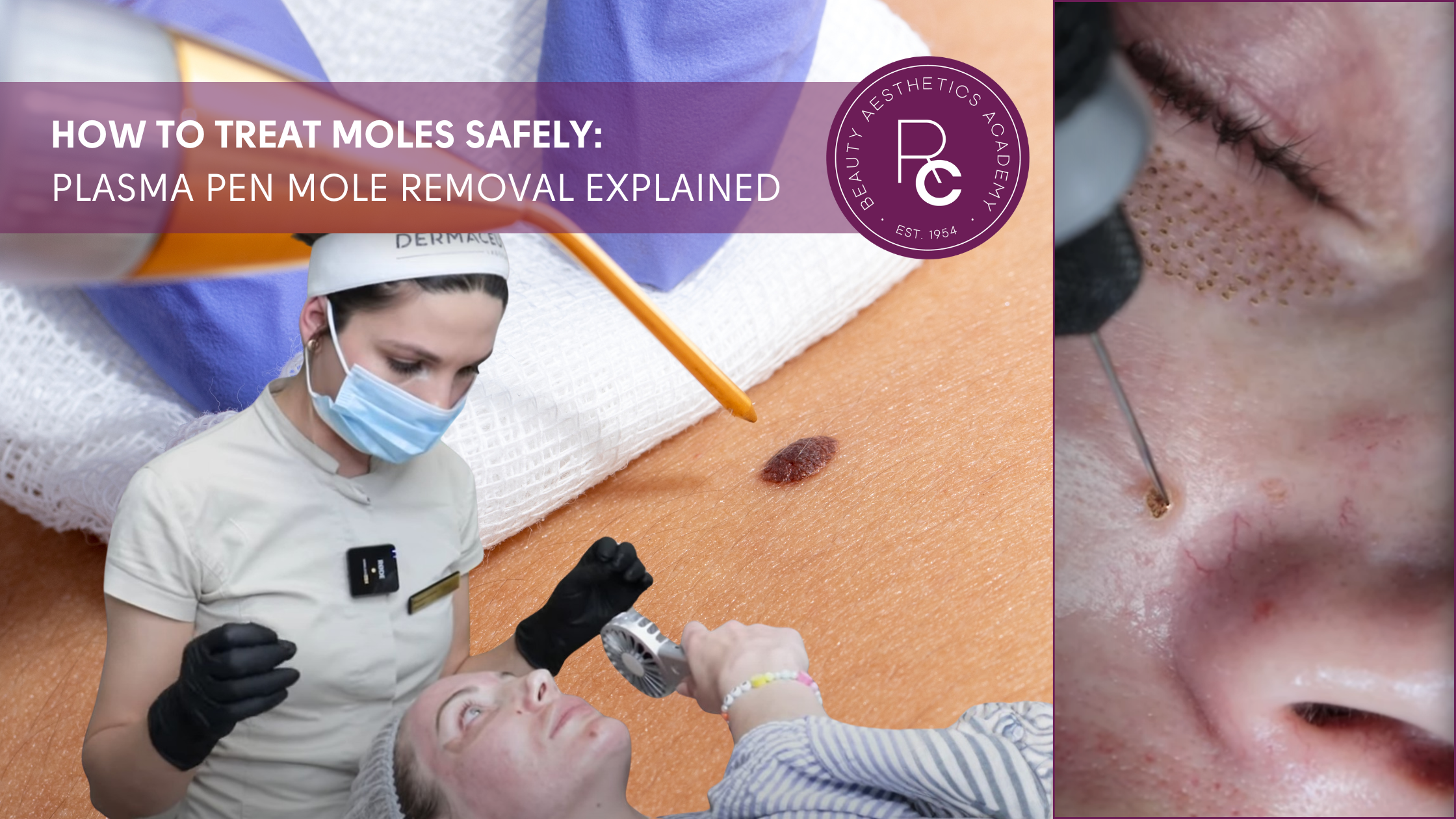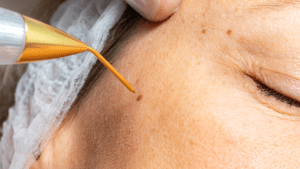
When clients sit in your chair and point to a mole that has bothered them for years, there is something deeply rewarding about being able to offer a solution. Mole removal with plasma pen has become increasingly popular in advanced aesthetics, and for good reason.
It offers precision, minimal downtime, and often remarkable results in just one session. But as with any advanced treatment, the difference between a satisfied client and a regretful one comes down to your knowledge, technique, and aftercare guidance.
What exactly is plasma pen mole removal?
The plasma pen creates a tiny, controlled arc of plasma energy that effectively vaporizes superficial tissue. When applied to benign moles, particularly those that are raised above the skin’s surface, it can gently remove the excess tissue and flatten the area to match the surrounding skin. The beauty of this approach is its precision. We can target just the mole itself without affecting healthy tissue around it.
We recently watched our Director of Education, Eleonora Androva, demonstrate this technique on a client with four facial moles. After applying numbing cream for about 15 minutes, she worked methodically across each mole. The client reported no discomfort, and the entire procedure took less than ten minutes. This efficiency is part of what makes plasma pen treatments so appealing to both practitioners and clients alike.
The treatment process: what to expect
When performed correctly, plasma pen mole removal follows a careful sequence. First, thorough consultation and assessment are essential. This is not a treatment to rush into. Once you have determined the mole is appropriate for treatment, the area is cleansed and numbed.
The actual treatment involves passing the plasma pen over the mole in gentle, controlled movements. You will notice the tissue immediately responds, often turning slightly darker as the plasma energy works. This is not burning in the traditional sense. It is a precise sublimation process that converts solid tissue directly to gas.
“I am careful not to wipe too aggressively during the procedure,” Eleonora explains. “Some practitioners make the mistake of removing too much of the initial crust that forms. This protective layer actually helps guide healing and prevents over-treatment.”
Immediately after treatment, the area will appear slightly raised and darker. This is completely normal and actually a good sign that the treatment has reached the appropriate depth. The treated area will form a protective crust over the next day or two.

Aftercare: the key to optimal results
Aftercare for plasma pen mole removal is refreshingly straightforward, but client compliance is everything. Eleonora’s guidance to her clients is crystal clear: “Leave it alone. Do not touch, do not pick, do not wash the area for a few days.”
This “dry healing” approach might seem counterintuitive to clients who are used to applying creams and ointments to healing skin, but it is crucial for plasma pen treatments. Water and excessive products can interfere with the natural healing process and potentially lead to infection or pigmentation issues.
For the first 48 hours, clients should avoid exercise that causes sweating, keep the face dry, and resist any urge to touch or pick at the treated area. The protective crust will naturally fall away after about 5-7 days, revealing fresh, new skin underneath.
Once this initial healing phase is complete, sun protection becomes absolutely essential. “No sun exposure for at least a month, and always apply a good sunscreen to the area,” Eleonora advises. This helps prevent post-inflammatory hyperpigmentation, which can be particularly noticeable on facial skin.
When plasma pen is not appropriate for mole removal
This is where ethical practice becomes non-negotiable. Plasma pen should never be used on moles that show any suspicious characteristics. The ABCDE rule is your guide here:
- Asymmetry: One half does not match the other
- Border: Irregular, ragged, or blurred edges
- Colour: Uneven colour or multiple colours within one mole
- Diameter: Larger than 6mm (though smaller moles can also be concerning)
- Evolving: Changing in size, shape, colour, or elevation
If a client presents with a mole showing any of these characteristics, the only responsible action is to refer them to a dermatologist or appropriate medical professional. No aesthetic treatment is worth risking a client’s health, and suspicious lesions require proper medical evaluation.
Even with seemingly benign moles, it is worth considering whether the client should seek medical advice before aesthetic removal. Some practitioners prefer to work only with clients who have had their moles checked by a doctor first, which creates an additional layer of safety and confidence.
When medical referral is necessary
It is essential to understand that as beauty professionals, we operate within clear boundaries. Before treating any mole or skin lesion with plasma pen, you must ensure the client has received appropriate medical clearance. This is not optional or simply “best practice” – it is a fundamental requirement.
Any client requesting mole removal should first be referred to their GP or a dermatologist to confirm the lesion is benign and suitable for aesthetic treatment. Without this medical confirmation, we simply cannot proceed, regardless of how harmless the mole may appear. Remember that we are not medically trained to diagnose skin conditions, and what looks like a simple mole could potentially be something requiring medical attention.
Even after receiving medical clearance, maintain detailed records of this referral process in your client’s notes. This protects both you and your client, demonstrating your commitment to working within your scope of practice and prioritizing client safety above all else.
Eleonora emphasizes this point strongly in her training: “Never be tempted to skip the medical referral step, even if a client is eager to proceed immediately. Your reputation and their wellbeing depend on following proper protocols. A responsible practitioner always knows when to refer and when to treat.”
Results and expectations
“Most clients see excellent results after just one session,” Eleonora notes. “The mole is typically flattened and much less noticeable, often blending seamlessly with the surrounding skin.”
However, it is important to set realistic expectations. Very raised or stubborn moles might require a second session, and there is always a small possibility of slight textural or pigment differences in the treated area. The skill of the practitioner makes an enormous difference here. Gentle, precise technique minimizes these risks significantly.
I asked Eleonora what advice she would give to practitioners new to plasma pen mole removal. Her response was thoughtful: “Respect the tissue. Less is often more with plasma treatments. You can always do a second session if needed, but you cannot undo overtreatment. And always, always prioritise client safety over everything else.”
See plasma pen mole removal in action
If you are curious about the technique and real-world application, I encourage you to watch Eleonora’s demonstration. Her gentle approach, clear communication with the client, and meticulous attention to detail showcase why proper training is so essential for these advanced treatments.
For Clients Seeking Plasma Pen Treatments
If you’re a client interested in receiving plasma pen treatment in London, visit Dermacure, our director’s luxury skin clinic. Located just a 3-minute walk from Baker Street tube station, Dermacure was founded by Eleonora Androva and offers a comprehensive range of advanced aesthetic treatments, including plasma pen for mole removal and eye rejuvenation. With over 14 years of experience in the aesthetic field, Eleonora brings the same expertise and careful approach to her clinic that she shares in our training courses.
For more information or to book a consultation, visit dermacureclinic.co.uk or call 0207 935 3405.
Taking your skills further
For those of you inspired to add plasma pen treatments to your practice, remember that proper training is not just about technique. It is about assessment, contraindications, managing client expectations, and comprehensive aftercare. Our Level 4 course in Plasma Pen techniques covers all these aspects and more, ensuring you have the confidence and competence to offer these treatments safely and effectively.
The versatility of this device continues to impress even seasoned practitioners, and I am looking forward to sharing more insights with you.
Until then, remember that in advanced aesthetics, your reputation is built on both your technical skill and your ethical judgment. The most successful practitioners are those who know not just how to perform a treatment, but when to say no and how to guide clients toward the safest, most appropriate solutions for their unique needs.
